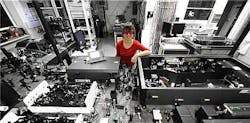Student-built STED microscope achieves 100 nm resolution
Diffraction limit has prevented optical microscopes from being able to discern details smaller than 200 nm, but super-resolution devices developed in recent years have managed to overcome this limit—namely stimulated emission depletion (STED) confocal microscopes. So Joanna Oracz, a student at the Ultrafast Phenomena Lab of the Faculty of Physics, University of Warsaw (FUW; Warsaw, Poland), has built a prototype STED confocal microscope as part of her thesis—one that achieves resolution twice that of a standard confocal microscope. As of next year, the new microscope will be used not only for optics research, but also to analyze biological samples.
An additional laser beam—a depletion beam—is used in STED microscopy. Given its wavelength, the beam induces stimulated emission in dye molecules it illuminates. Molecules that have lost energy as a result of stimulated emission are no longer able to fluoresce. Therefore, their light (similarly to the light from stimulated emission) will not pass through the filter in front of the detector, and they will not be visible on the recorded image. With STED, the depletion beam is donut-shaped; if a beam of this shape is properly synchronized in time and space with the illuminating beam, fluorescence will occur first in the area of the sample located in the center of the depletion beam.
The prototype STED confocal microscope built by Oracz at FUW has 100 nm resolution, and uses commercially available elements. Her biggest obstacle was to ensure that both laser beams overlapped. In order to observe the STED effect, both beams need to be ideally aligned—the minimum of the depletion beam needs to closely overlap with center of the excitation beam, she says.
Efforts are underway to further increase the resolution of Oracz's device, with the goal of reaching around 60 nm. This would make it possible to observe details as minute as dendritic spines of neurons.
Oracz notes that when she began working on her STED device one year ago, there was only one STED microscope in Poland, which was purchased for a million and a half euros.
For more information, please visit http://www.fuw.edu.pl.
